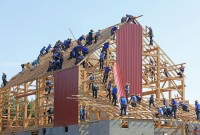- Home
- Business Processes
- Industry Knowledge
- Aerospace Industry
- Automotive Industry
- Banking Domain
- BFSI Industry
- Consumer/ FMCG Industry
- Chemicals Industry
- Engineering & Construction
- Energy Industry
- Education Domain
- Finance Domain
- Hospitality Domain
- Healthcare Industry
- Insurance Domain
- Retail Industry
- Travel and Tourism Domain
- Telecom Industry
- Leadership Skills
- eLearning
- Home
- Leadership Skills
- Leadership & Management
- Behavioral Approach to Management
Behavioral Approach to Management
The behavioral management theory had a profound influence on management by focusing on understanding the human dimensions of work. It is also called human relations movement as behavioral theorists focused on managing productivity by understanding factors of worker motivation like their needs and expectations, personality, attitudes, values, group behavior, conflict, and group dynamics. It advocated the use of psychological techniques to motivate employees.
The behavioral school of management emphasized what the classical theorists ignored which is the human element of the workplace. While classical theorists only viewed the organization from a production perspective, the behavioral theorists also focused their study on an individual’s attitudes, behaviors, and group dynamics in the workplace culture.
Hawthorne Studies
The behavioral approach emerged primarily as an outcome of the Hawthrone studies. Many Parke Follet, Elton Mayo, and his associates, Abraham Maslow, Douglas MCgradgor, and Chris Angyris were the major contributors to this school. As part of these studies, the researchers concluded that the workers worked harder because they thought that they were being monitored individually.
This study established the behavioral change that happened due to an awareness of being observed, resulting in active compliance with the supposed wishes of researchers, because of special attention received, or positive response to the stimulus being introduced.
Elton Mayo's experiments showed an increase in worker productivity was produced by the psychological stimulus of being singled out, involved, and made to feel important. Researchers hypothesized that choosing one's own coworkers, working as a group, being treated as special, and having a sympathetic supervisor were the real reasons for the productivity increase.
One interpretation was that "the six individuals became a team and the team gave itself wholeheartedly and spontaneously to cooperation in the experiment. Hawthorne Effect can be summarized as “Employees will respond positively to any novel change in a work environment like better illumination, clean work stations, relocating workstations, etc. Employees are more productive because they know they are being studied.
These findings made Mayo and Roethlisberger conclude that a leader has not only to plan, decide, organize, lead, and control but also consider the human element. This includes the social needs of being together and being recognized for the work interaction of the group members with each other and their wellbeing. A good leader ought to keep the above aspects in his style of working with people and supervising their work.
Maslow's Hierarchy of Needs
Abraham H Maslow (1908-1970), the psychologist, theorized that people were motivated by a hierarchy of needs. Maslow (1943) focused on human needs. Maslow's hierarchy of needs is a motivational theory that explains that people are motivated by five basic categories of human needs. These needs are physiological, safety, love and belonging, esteem, and self-actualization.
His theory rested on three assumptions:
- All of us have needs which are never completely fulfilled
- Through our acts, we try to fulfill our unsatisfied needs
- Human needs occur in the following hierarchical manner:
- Physiological needs;
- Safety or security needs,
- Belonging needs or self-fulfillment needs
According to Maslow, once needs at a specific level have been satisfied, they no longer act as motivators of behaviors. Then the individual strives to fulfill needs at the next level. Managers who accepted Maslow's hierarchy of needs attempted to change their management practices so that employees' needs could be satisfied.
This theory established the principle that a leader's behaviors can be conditioned in a manner that one can have a specific response to specific stimuli. The behavioral theory promotes the value of leadership styles with an emphasis on concern for people and collaboration. It promotes participative decision making and team development by supporting individual needs and aligning individual and group objectives.
It helps managers evaluate and understand how their behavioral style as a manager affects their relationship with the team and promotes commitment and contribution towards organizational goals. This theory helps managers find the right balance between different styles of leadership, and helps them decide how to behave as a leader, depending on concerns for people and for productivity.
Suggested Reading and Resources
Related Links
You May Also Like
-
Team leadership theory is a recent leadership theory that does not discriminate between the leader and the other team members. The approach considers contributions from each team member to be critical for organizational success. This approach focused on the overall team effectiveness and team problems are diagnosed and action is taken to remediate weakness. This approach provides for taking corrective action when the leader deems necessary.
-
Hawthorne Studies - Leadership
The Hawthorne studies were conducted on workers at the Hawthorne plant of the Western Electric Company by Elton Mayo and Fritz Roethlisberger in the 1920s. This study established the behavioral change that happened due to an awareness of being observed, resulting in active compliance with the supposed wishes of researchers, because of special attention received, or positive response to the stimulus being introduced.
-
Quantitative Theory of Management
The quantitative management approach is given by the mathematical school that recommends the use of computers and mathematical techniques to solve complex management issues and assist in the managerial decision-making process. Managers observe historical quantitative relationships and use quantitative techniques such as statistics, information models, and computer simulations to improve their decision making.
-
Thinking & Problem Solving Skills
Today's dynamic business world demands that you make decisions that significantly boost productivity and drive competitive advantage. But how do you know whether a decision will benefit the organization? And how do you know that the decisions are based on rational and statistical reasoning? Explore how to become a dynamic problem solver with the skills to make accurate decisions.
-
Modern Approaches to Management
The modern approaches to management look at organizational management in the current context. They take a holistic approach and look at organizations as a collection of interrelated parts influenced by both internal dynamics and also the larger external environment. These modern management theories have played a significant role in the evolution of management studies.
-
The concept of management refers to the process of planning, organizing, staffing, directing, coordinating, and controlling to achieve organizational goals. It is the management of human, physical, financial, and other valuable resources of the organization in an effective and efficient manner to achieve business objectives.
-
In its simplest sense, decision-making is the act of choosing between two or more courses of action. Decision making is a key skill in the workplace and is particularly important if you want to be an effective leader. When decisions have to be made, there are several stages that you should go through to reach a practical solution. Understand the meaning and importance of decision making and how to look at it as a process.
-
In today's business world, proficiency in management skills is essential for career growth and success. Managerial skills can be defined as attributes or abilities that are essential for every leader and manager to succeed and fulfill specific tasks expected from them by the organization.
-
Maslow's hierarchy of needs is a motivational theory that explains that people are motivated by five basic categories of human needs. These needs are physiological, safety, love and belonging, esteem, and self-actualization. There is a little scientific basis for this concept of a hierarchy of needs.
-
Theory Z also called the "Japanese Management" style is a leadership theory of human motivation focused on organizational behavior, communication, and development. It assumes that employees want to enter into long term partnerships with their employers and peers. Offering stable jobs with an associated focus on the well-being of employees results in increased employee loyalty to the company.
Explore Our Free Training Articles or
Sign Up to Start With Our eLearning Courses

About Us
Learning
© 2023 TechnoFunc, All Rights Reserved










